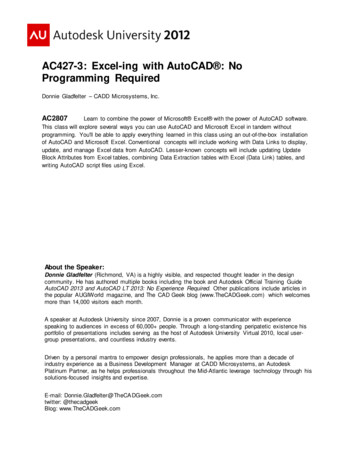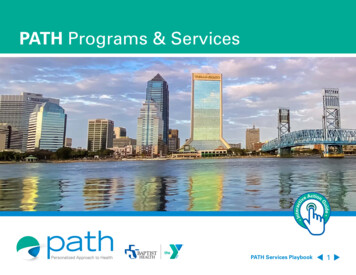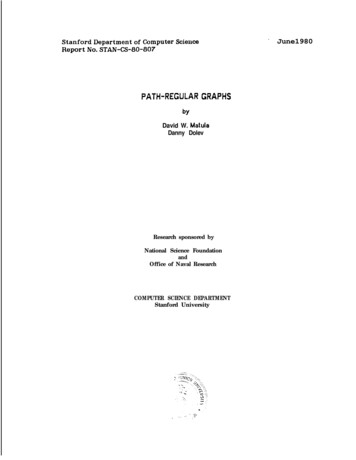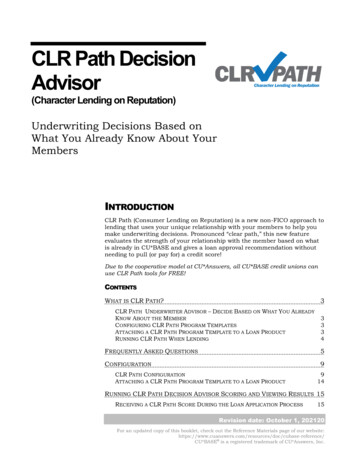
Transcription
Economic Conditions and the Path ofMonetary PolicyRobert S. KaplanPresident and CEOFederal Reserve Bank of DallasSeptember 29, 2020The views expressed are my own and do not necessarily reflect official positions of the Federal Reserve System.I would like to acknowledge the contributions of Tyler Atkinson, Jackson Crawford, Jim Dolmas, Marc Giannoni,Drew Johnson, Lutz Kilian, Evan Koenig, Karel Mertens, Anthony Murphy, Pia Orrenius, Alex Richter,Kathy Thacker, Jesse Thompson, Joe Tracy and Mark Wynne.
Economic Conditions and the Path of Monetary PolicyRobert S. KaplanIn the September 2020 Federal Open Market Committee (FOMC) meeting, the Committee left thefederal funds rate target range unchanged at 0 to 0.25 percent. The Committee also said that it“expects it will be appropriate to maintain this target range until labor market conditions havereached levels consistent with the Committee’s assessments of maximum employment andinflation has risen to 2 percent and is on track to moderately exceed 2 percent for some time.”I dissented from this statement because, while I expect it will be appropriate to keep the federalfunds rate in the current range until the economy is on track to achieve the Committee’s dualmandate objectives, I believe that the Committee should retain greater policy rate flexibilitybeyond that point. In this regard, I believe that the difference between remaining “accommodative”and keeping rates at zero becomes increasingly important as we approach achievement of our dualmandate objectives.Once we have battled and moved beyond the COVID-19 pandemic over the next two to threeyears, I believe the world is likely to look very different than it does today—in ways that arepredictable and ways that are likely not predictable. I would like future Committees to have theflexibility to adapt to those future economic conditions so they can use their best judgment indeciding on the appropriate stance of monetary policy.In this essay, I will discuss various economic issues, briefly explain the Fed’s new policyframework and discuss my views regarding the appropriate stance of monetary policy.The U.S. Economy—Addressing the PandemicAs a result of the coronavirus pandemic and the related shutdown, the U.S. economy contractedapproximately 32 percent on an annualized basis in the second quarter of 2020, and theunemployment rate rose to 14.7 percent in April. 1 The U-6 measure of unemployment—whichtakes into account the unemployed, plus workers who have given up looking for a job and thoseworking part-time who would prefer to work full-time—rose to 22.8 percent in April. 2 Thesefigures compare to a prepandemic unemployment rate of 3.5 percent and a U-6 reading of 7.0percent in February of this year.3In response to the pandemic, the Federal Reserve cut the federal funds rate from a range of 1.5 to1.75 percent in February to a range of 0 to 0.25 percent by March. In addition, the Committeeinitiated a program of purchases of Treasury securities and agency mortgage-backed securities(MBS) totaling at least 500 billion and at least 200 billion, respectively, at a pace appropriate tosupport the smooth functioning of markets for Treasury securities and agency MBS. From midMarch until the end of May, Fed holdings of Treasury securities increased 1.5 trillion andholdings of agency MBS increased approximately 500 billion.4 Since May, the pace of additionalpurchases has been 80 billion of Treasuries and 40 billion of agency MBS per month.1
The Fed also lowered the rate charged to banks at the discount window from 225 basis points to25 basis points (reflecting a 150 basis-point reduction in the fed funds rate and a 50 basis-pointnarrowing in the spread of the primary credit rate relative to the top of the target range) in order tohelp ensure banks had sufficient liquidity and the ability to lend to customers.In late March, Congress passed the Coronavirus Aid, Relief, and Economic Security (CARES)Act. This act authorized the Treasury to make equity investments in a range of liquidity and creditfacilities established by the Federal Reserve under section 13(3) of the Federal Reserve Act. Theseprograms were aimed at stabilizing money market funds and the markets for corporate bonds,asset-backed securities and municipal bonds.5 These and other actions helped to restore marketfunctioning and helped to improve access to capital for small, mid-sized and large businesses.As part of the CARES Act, Congress also authorized the Paycheck Protection Program (PPP). Thisprogram, administered by the Small Business Administration, allowed banks to provide forgivableloans to small businesses in order to maintain their payrolls, hire back employees who may havebeen laid off, and cover applicable overhead. The CARES Act also authorized additionalunemployment insurance benefits and one-time cash payments which allowed millions of familiesto receive vital income support as a result of heightened unemployment amid the economiccontraction.As a result of extraordinary efforts to limit the spread of the virus through lockdowns andadherence to public health protocols, the incidence of the virus declined sufficiently in April andMay to allow several states to begin the process of reopening their economies. It is the view ofDallas Fed economists that the U.S. economy likely bottomed out in April and began to grow againin May and June.However, due to a resurgence of the virus in certain states beginning in June, the rate of growthslowed somewhat in July and August. Through the reimposition of targeted business closures andthe heightened emphasis on adherence to public health protocols of social distancing and maskwearing, the rate of transmission of the virus began to moderate in August and September. Evenwith these reopening challenges, the economy has recovered faster than expected, and Dallas Fedeconomists forecast that third-quarter gross domestic product (GDP) growth in the U.S. will beapproximately 30 percent at an annualized rate.The Labor MarketThe August headline unemployment rate stood at 8.4 percent, and the U-6 measure ofunemployment was 14.2 percent.6 In addition, the labor force participation rate—the rate at whichthose 16 years old and older are either employed or actively looking for work—was 61.7 percent(this compares with a reading of 63.4 percent in January 2020).7 However, the overall laborstatistics mask much greater hardship among key groups in our society. In particular, theunemployment rates of Blacks and Hispanics increased to 16.7 percent and 18.9 percent,respectively, in April. 8 This outpaced the unemployment rate of whites, which peaked at 14.2percent.9 While today the unemployment rate for whites has declined to 7.3 percent, theunemployment rate for Blacks and Hispanics remains more elevated at 13.0 percent and 10.52
percent, respectively.10 These disparities are indicative of how the pandemic hasdisproportionately impacted person-to-person service sector jobs, and those with lower levels ofeducational attainment (see page 5 of this essay). These statistics reinforce the need for greaterefforts to invest in education and skills training in order to create a stronger and more inclusivelabor market and help ensure that key groups of our society are not left behind in this recovery.Consumer SpendingOne of the unusual aspects of this pandemic has been the mix and overall resilience of consumerspending. In spite of the severe damage to employment and small businesses since the start of thepandemic, we have seen that consumer spending on goods has been very strong. While goodsspending has exceeded prepandemic levels since June, we are seeing that spending on services hasimproved but is still below prepandemic levels.The strength in consumer goods spending is significantly different from prior recessions. In pastrecessions, consumer spending on services has typically remained steady while durable goodsconsumption has declined. Dallas Fed economists believe that the resilience of consumer spendingduring this pandemic has been bolstered by a substantial level of fiscal relief, particularly in theform of one-time payments and supplemental unemployment benefits. As a result, aggregatepersonal income levels have actually exceeded pre-COVID levels, 11 something unique to thisrecession. Of course, a key risk we are watching carefully is the potential waning of unemploymentbenefits and other forms of fiscal relief, which could cause more typical recessionary dynamics toemerge. The emergence of these dynamics would certainly create headwinds for continuedrecovery.The OutlookDallas Fed economists expect continued growth through the rest of this year. We expect that 2020GDP will show a contraction of approximately 3.0 percent and that the unemployment rate willend the year at approximately 7.5 percent. Inflation, as measured by core personal consumptionexpenditures (PCE), is expected to be running at approximately 1.6 percent by year-end 2020.12We forecast that the U.S. economy will grow by roughly 3.5 percent in 2021 and that theunemployment rate will decline to approximately 5.7 percent by year-end 2021. Inflation isexpected to modestly accelerate, increasing to approximately 1.8 percent by year-end 2021. Theseforecasts are, of course, highly uncertain because they are heavily dependent on the path of thevirus and the level of adherence to public health protocols, such as mask wearing and socialdistancing. They also depend heavily on continued fiscal support, as well as the timing of apotential vaccine that is effective and can be widely administered.Tracking Mobility and EngagementA primary determinant of the rate of growth for the remainder of this year and next year will bethe incidence of the virus. In order to monitor the impact of the virus on the economy, we trackmobility through a metric called the Dallas Fed Mobility and Engagement Index (MEI). This indexcombines several different measures of the spatial behavior of anonymized cellphone users in order3
to gauge the level of engagement of the population in a wide range of activities. This measure hasallowed our economists to gain real-time insight into the economic impact of the pandemic. TheMEI is measured daily, at the national, state and county levels.13The U.S. measure of this index stood at 3 in the week ended Feb. 29. It began to deterioratesharply in the week ended March 14. It bottomed out at -100 in the week ended April 11 and thenbegan to improve substantially in late April. The index continued to improve sharply until midJune (with a reading of approximately -40) and then began to stall out as COVID cases surged inthe southern and western portions of the U.S. Since August, this measure has shown modestimprovement, and it currently sits at approximately -38. Chart 1 tracks the progression of this indexin the U.S. since late-February 2020.It is our view that this MEI measure is a good proxy for the direct impact of the pandemic oneconomic activity and highlights trends in the economy. Dallas Fed economists believe that theMEI is highly correlated with the path of the virus, especially when cases are rising. This indexhighlights the importance of limiting the spread of the virus while maintaining or improving thelevel of mobility. Our effectiveness in managing this virus will continue to be a primarydeterminant of economic growth in the U.S. How well do we follow health protocols of socialdistancing and mask wearing? Will there be a vaccine which can be widely distributed? Thesequestions will help determine how quickly we return to higher levels of engagement and, as aconsequence, how fast we recover from this pandemic.4
Structural Changes in the U.S. Economy: Demographics, Productivity and TechnologyEnabled DisruptionIn the months and years leading up to the pandemic, I spoke regularly about some of the keystructural challenges facing the U.S. economy (see the essay “Economic Conditions and the KeyStructural Drivers Impacting the Economic Outlook,” Oct. 10, 2019). Sluggish workforce growthdue to aging of the population has created a headwind for GDP growth. Finding ways to improveworkforce growth is likely to be critical to improving GDP growth in the U.S. Sluggishproductivity growth has also created headwinds to economic growth. Our economists believe thataddressing lagging early-childhood literacy, improving educational attainment levels, beefing upskills training across the U.S. and creating more access to broadband as well as other targetedinfrastructure investments are likely to be key structural changes necessary to improveproductivity. These investments will particularly help to improve the future adaptability andemployability of those with lower levels of educational attainment.We have seen in this pandemic that job losses have disproportionately impacted those with lowerlevels of educational attainment. In April, at the height of the pandemic, those individuals withless than a high school diploma had an unemployment rate of approximately 21.2 percent, whilethose who had completed college with a bachelor’s degree had an unemployment rate ofapproximately 8.4 percent.14 This disparity reflects the fact that those with lower levels ofeducational attainment may be more likely to be employed in person-to-person service sector jobsand, as a consequence, are less likely to be able to work remotely.15 As a result, these workershave been much more vulnerable to job losses and losses of income. In a world where technologyand technology-enabled disruption is accelerating, improving the adaptability of lower-incomeworkers is likely to be a major challenge.The emphasis on remote work and engagement has meant that people are spending their time andtheir money in dramatically different ways than before. They are far more likely to be conductingmeetings remotely, traveling less, buying goods online and having their purchases of goodsdelivered. This acceleration in the rate of technology and technology-enabled disruption ischanging the competitive landscape in a wide range of industries. Some of these changes mayreverse after we have weathered this pandemic, while others are likely to be more lasting.As was the case leading up to the pandemic, this trend is likely limiting the pricing power ofbusinesses. To respond to this trend, businesses are investing substantially more in technology toreplace people, lower their costs and improve their competitiveness. This trend is evidenced by theincreasing percentage of nonresidential fixed investment accounted for by investments in computerand peripheral equipment, and spending on software.Energy DevelopmentsI have spoken throughout this year about the enormous challenges the coronavirus has posed forthe U.S. energy industry. In early March, after OPEC-plus failed to reach an agreement onproduction cuts, Saudi Arabia announced that it would cut its selling prices and increase its crudeoil production. This retaliatory announcement was coincident with the beginning stages of an5
unprecedented decline in global oil demand as a result of COVID. These events have hadsignificant negative implications for U.S. oil production.It is the view of our energy economists that U.S. oil production will decline from approximately12.8 million barrels per day (mb/d) in December 2019 to approximately 10.7 mb/d by December2020.16 Oil production from the Permian Basin is expected to decline from approximately 4.7 mb/din December 2019 to approximately 3.8 mb/d in December 2020.17 Consistent with this, thenumber of oil wells completed is projected to fall 50 percent from 2019 to 2020, and overall U.S.exploration-and-development capital spending will likely decline by approximately 50 percent in2020.18Our economists believe that U.S. oil production growth will likely be flat during 2021. Thisforecast assumes that new drilling and well completions will be sufficient to replace decliningproduction from existing wells.Global energy consumption fell to approximately 83 mb/d in the second quarter, a decline of nearly17 percent from prepandemic levels.19 During the subsequent recovery, consumption has risen tonearly 90 mb/d.20 Of course, future levels of demand will be heavily impacted by the timing ofwhen individuals increase their engagement in a broader range of transportation activities,including the extent to which they return to airline travel. Balancing this weakness in demand witha substantial decline in production, it is the view of Dallas Fed energy economists that globalexcess oil inventories will not be worked off before late 2021.The Fed’s New Monetary Policy FrameworkOn Aug. 27, the Federal Reserve announced amendments to its monetary policy framework.21 Thisannouncement was the culmination of a two-year review of its policy framework, which involvedthree distinct components. First, the Federal Reserve hosted a series of Fed Listens events acrossthe country to engage various stakeholders to hear directly from them about how monetary policydecisions affect their communities. Second, the Federal Reserve convened a research conferenceat which prominent academic experts addressed economic topics central to the review. Finally,over the course of several meetings, the Committee explored a range of issues that were broughtto light during the review. In its new framework, the FOMC made key changes with regard to bothparts of its dual mandate—maximum employment and price stability.On maximum employment, the FOMC emphasized that maximum employment is a broad-basedand inclusive goal and reported that its policy decisions would be informed by its “assessments ofthe shortfalls of employment from its maximum level.” The original document referred to“deviations from its maximum level.” The previous expansion demonstrated the benefits of astrong labor market and the difficulty of assessing the level of maximum employment in real time.Unemployment fell to levels previously thought to be unsustainable, and we were able to bring inmany workers who had previously been left behind. This occurred against the backdrop ofrelatively muted inflation. Based on this experience, the Committee decided to change the policyframework to signal that higher employment, in the absence of unwanted increases in inflation orthe emergence of other risks, will not by itself be a cause for policy concern.6
On price stability, the FOMC adjusted its strategy for achieving its longer-run inflation goal of 2percent by noting that it “seeks to achieve inflation that averages 2 percent over time.” The revisedpolicy states that “following periods when inflation has been running persistently below 2 percent,appropriate monetary policy will likely aim to achieve inflation moderately above 2 percent forsome time.” This change was made in an effort to ensure that inflation expectations do not driftdown over time and that they remain well-anchored at 2 percent. If inflation expectations were todrift lower, the nominal level of interest rates would be lower, too, leaving less room for the FOMCto cut rates when needed to support the economy.The Stance of Monetary PolicyThe September FOMC DecisionIn light of the economic devastation caused by the virus and related lockdowns, I believe it hasbeen appropriate for the Federal Reserve to take extraordinary actions to stabilize markets and toimprove access to capital for small, mid-sized and large businesses. In addition, I believe it hasbeen appropriate for the Fed to maintain the setting of the federal funds rate at 0 to 0.25 percentand to purchase Treasury securities and agency mortgage-backed securities to support the smoothfunctioning of these markets and to provide some additional level of accommodation during thepandemic.In my September meeting dissent, I emphasized that I believe the current setting of the federalfunds rate will be appropriate until the Committee is confident that the economy has weatheredthe pandemic and is on track to achieve its maximum employment and price stability goals asarticulated by the new policy framework. My best judgment is that it will take at least until late2022 or sometime in 2023 for these criteria to be met. However, beyond that point, I believe thatthe Committee should retain greater policy rate flexibility to decide on the appropriate stance ofmonetary policy.Accommodative Versus Zero—The Role of R*There is an important difference between remaining “accommodative” and keeping rates at zero.I believe, after we have fully weathered this crisis, we should be willing to be more accommodativethan in the past in order to create a stronger and more inclusive labor market and make progresson achieving our 2 percent average inflation target. However, I am cognizant that as the economyapproaches full employment and we are on track to reach our price stability objectives, theequilibrium nominal rate of interest (the federal funds rate at which monetary policy is neitherrestrictive nor accommodative—often referred to as R*) is likely to increase. This means that aswe approach achievement of our dual-mandate objectives, the stance of monetary policy willactually become more accommodative if the fed funds rate were to remain at zero. I can understandwhy future Committees will want to remain accommodative at that point in order to ensure weachieve our goals, but will they want to be effectively increasing the level of accommodation bykeeping the federal funds rate at zero? I would like future Committees to have the flexibility tomake this judgment.7
Monitoring Excessive Risk TakingI believe there are real costs to keeping rates at zero for a prolonged period of time. Keeping ratesat zero can adversely impact savers, encourage excessive risk taking and create distortions infinancial markets. Excessive risk taking and distortions in financial markets could lead to greaterfragilities, excesses and imbalances which could ultimately jeopardize the attainment of the Fed’sobjectives. These fragilities and tail risks are often much easier to recognize in hindsight than inreal time. For example, some market observers have commented that the seizing up of financialmarkets in March was due in part to COVID and related shutdowns but may have also been due,in part, to some amount of forced selling by over-risked market participants. While the FederalReserve has oversight and visibility regarding banks in the U.S., it does not have supervisoryjurisdiction or a high level of visibility regarding the nonbank financial markets.Adapting to a Changing WorldThe post-COVID economy is likely to look very different from the economy we are in today. I amreluctant to restrict the ability of future Committees to use their best judgment to adapt to thesechanges in ways they believe help achieve our dual-mandate objectives. Future Committees willneed to assess the implications of acceleration in the rate of new technology adoption andtechnology-enabled disruption, changes in our views regarding how monetary policy impactsinflation, changes in tax policy, changes in regulatory policy, changes in trade policy, the role ofthe dollar as the world’s reserve currency, and other developments—some foreseeable and somethat are hard to predict as we sit here today. One of the great strengths of the FOMC is the gatheringof a diverse group of decision-makers who are empowered to share views, energetically debateand ultimately use their best judgment, based on analyses of current and expected economicconditions, in order to make sound policy decisions that are forward looking.For example, the pandemic has dramatically accelerated investment by for-profit and not-for-profitenterprises in technology and the adoption of new models that accelerate the trend of technologyenabled disruption. These trends are likely to continue to mute the pricing power of businesses.The expected strengthening of this structural trend may well offset the cyclical inflationary impactof a tightening job market. It is unclear to me how these structural forces will interact with thecyclical forces in impacting inflation in the years ahead. In addition, I believe that we will learn alot over the next two years about the impact of monetary policy on achieving our inflation goals,and I believe more research needs to be done on pricing dynamics and technology-enableddisruption.The Rationale for Forward GuidanceForward guidance is communication by the Fed which indicates its intentions regarding the likelyfuture path of monetary policy. It can be a powerful tool that comes with potential benefits andcosts. A commitment to keeping rates at zero based on certain conditions being met can, inprinciple, help lower today’s longer-term yields and, thus, provide additional stimulus that couldaccelerate the economy’s return toward our longer-run goals. However, I am skeptical about the8
benefits of enhanced forward guidance at the moment because rates are already historically lowand, even before this meeting, market expectations were for them to stay low for the next fewyears. In addition, the latest FOMC Summary of Economic Projections indicated that the bulk ofFOMC participants expect the federal funds rate to remain at 0 to 0.25 percent through the end of2023. Given these expectations, it was my preference to defer using enhanced forward guidanceas a tool until a time in the future when the benefits would be more compelling.Looking ForwardI believe that, today, our primary focus should be on fighting the COVID pandemic and gettingthe U.S. economy on track to meet our dual-mandate objectives of full employment and pricestability. This means keeping the federal funds rate at its current setting, continuing our 13(3)programs until we judge that they are no longer required, and considering use of other tools. Inaddition, I believe there needs to be continued focus on doing more to help small and mid-sizedbusinesses get access to capital.While monetary policy will play a critical role in the recovery, we will also need additional fiscalmeasures that provide relief to the unemployed and those working part time who would prefer towork full time. In addition, fiscal relief would be highly beneficial to state and local governmentsthat are trying to recover from a fiscal hole created in the first and second quarters of this year.Lack of additional fiscal relief would create a key downside risk to my economic forecast for 2020and 2021.While appropriate monetary and fiscal policies are critical to recovery, a primary determinant ofthe rate of recovery will be how well we manage the virus—particularly, wearing masks, socialdistancing and rigorously following other public health protocols. In addition, we must continueto invest in the development of widespread, rapid and accurate testing as well as work to beef upour ability to do effective contact tracing. Even with an effective vaccine, which will hopefully beapproved in the next several months, these measures are likely to be vital until we are able toconfidently inoculate the bulk of the population.I remain confident that the U.S. economy will recover from the COVID crisis as each of uscontinues to do our part. I am also confident that the Federal Reserve will do all that it can to makesure we successfully recover from this pandemic and move the economy forward toward achievingour full employment and price stability goals.Notes1Data are from the Bureau of Economic Analysis (BEA), published Aug. 27, 2020, and from the Bureauof Labor Statistics (BLS) as of August 2020.2As of August 2020. Data are from the BLS.3See note 2.4Data are from the Federal Reserve Bank of New York.5See “Federal Reserve Takes Additional Actions to Provide up to 2.3 Trillion in Loans to Support theEconomy,” Federal Reserve Board of Governors, published April 9, 2020.9
6See note 2.See note 2.8See note 2.9See note 2.10See note 2.11Data are from the BEA, published Aug. 28, 2020.12This compares to a 12-month core personal consumption expenditures inflation rate of 1.9 percent inFebruary 2020, according to the BEA. See note 11.13For more information regarding the MEI and its methodology, see “Dallas Fed Mobility andEngagement Index Gives Insight into COVID-19’s Economic Impact,” by Tyler Atkinson, Jim Dolmas,Christoffer Koch, Evan Koenig, Karel Mertens, Anthony Murphy and Kei-Mu Yi, Dallas Fed Economics,May 21, 2020.14See note 2.15See “Working from Home During a Pandemic: It’s Not for Everyone,” by Yichen Su, Dallas FedEconomics, April 7, 2020.16Data are from the International Energy Agency (IEA) and the Federal Reserve Bank of Dallas.17See note 16.18Data are from the Federal Reserve Bank of Dallas.19Data are from the IEA.20See note 18.21See “Statement on Longer-Run Goals and Monetary Policy Strategy,” Federal Reserve Board ofGovernors, amended Aug. 27, 2020.710
Robert S. Kaplan . President aEO nd C Federal R eserve Bank of Dallas September 29, 2020 . 1 . Economic Conditions and the Path of Monetary Policy . . Dallas Fed economists believe that the resilience of consumer spending during this pandemic has been bolstered by a substantial level of fiscal , particularly in the relief .











